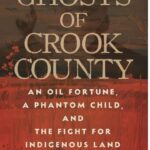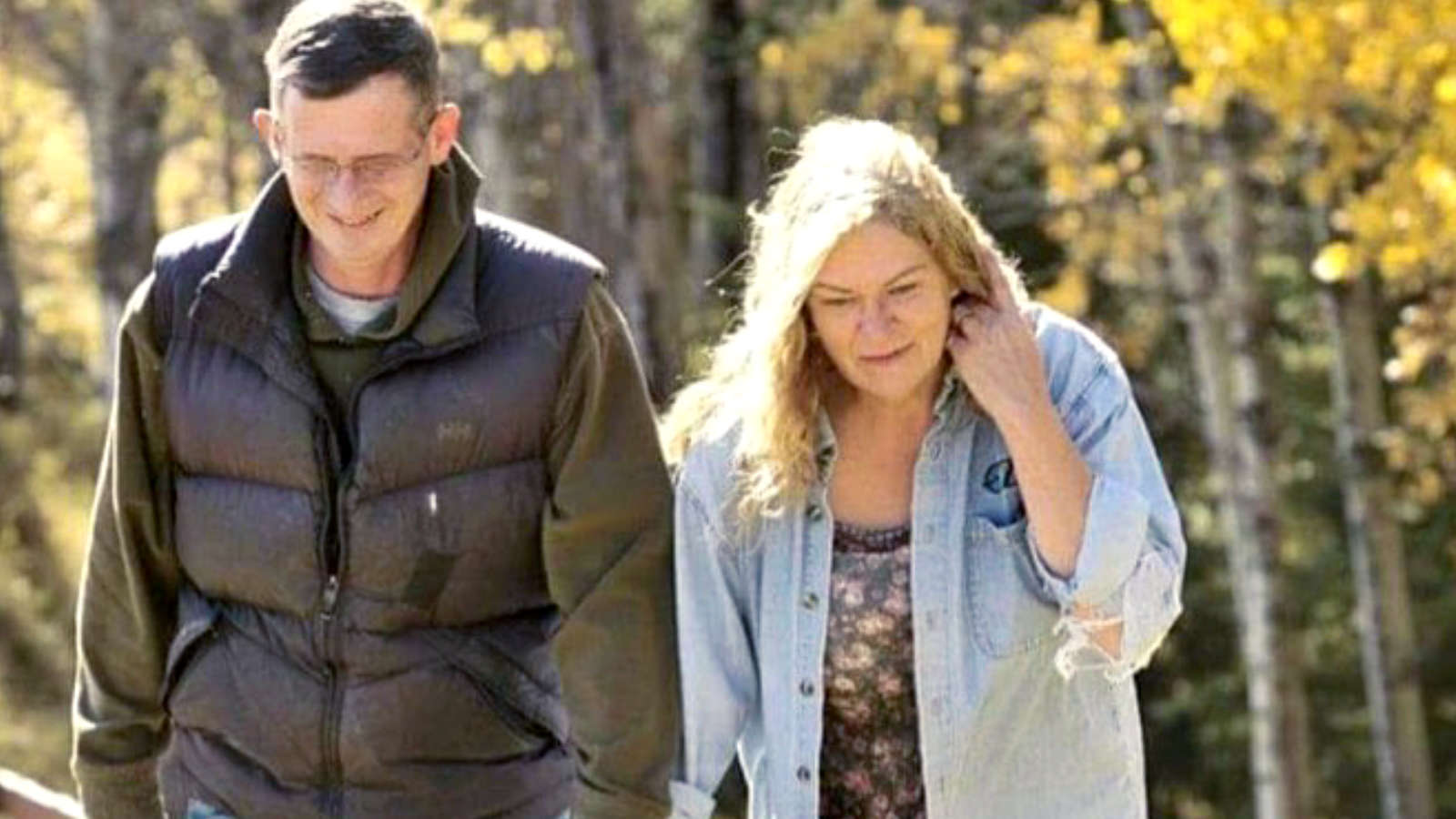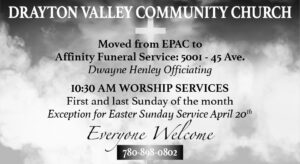The family of a missing Breton man who disappeared seven years ago are still hoping for help from the public.
Andrew George Nicoll was last heard from on April 21, 2014. His daughter, Bronwyn Taylor, had just been to visit him for Easter the day before.
Taylor says she and her father were very close and had been texting throughout the day. The last text she received from him was at 3:15 p.m. At that time Nicoll was outside working on his deck. At 4 p.m. Taylor sent him another text, but this one was never read.
When the text message went unanswered, Taylor wasn’t initially concerned. Her father lived on a large piece of land near Breton. The area was isolated and the cell service wasn’t always great, so she assumed it just hadn’t gone through.
It was when she received the call that he hadn’t shown up for work the next morning that she knew something was wrong.
As a former member of the Royal Navy, police officer and volunteer firefighter, Taylor knew that her father would not be irresponsible about his work shift. His employer, who also recognized that this was abnormal behaviour, had gone out to his home to check on him, but he wasn’t there.

Emmaus Lutheran Church
A community of faith passionately walking the road of life with the Lord Jesus. Phone: 780-542-5101, Drayton Valley Alberta
Dr. Chris Birchall Dentistry
Dr. Birchall Dentistry in Drayton Valley, Alberta. A dentist in Drayton Valley, Alberta.

Life Church Drayton Valley
We know that exploring a new church can be an overwhelming experience. To help you

Living Spirit United Church
Everyone welcome. Sunday Worship, 10:30 We are residents of Drayton Valley, members and adherents of

All Saints Anglican Church
Drayton Valley, All Saints Anglican Church participates in the Anglican Liturgy, which comforts and sustains us. Many have said that in such a busy and changing world it is important to come to a place that feels like home.
Taylor called the RCMP immediately and travelled out to his house. She says she can remember some people suggesting he just took off or perhaps killed himself – his wife had died of cancer two years prior – but what Taylor saw told her this wasn’t the case.
Taylor had just been to visit him the day before he disappeared. “He was in really good spirits. No indication of [him] being suicidal. He was not, whatsoever,” she said.
Nicoll had been working on his deck, getting his place ready to be sold. All of his tools were left out and he’d been in the middle of adding oil to his chainsaw.
He’d also put both dogs inside the house, something he only did when there were visitors coming up the driveway. Inside they could see that he’d gone grocery shopping that day, there was chicken thawing for supper in the microwave, and the dog dishes were filled with food and sitting on the countertop.
“The only reason the dogs would ever be locked inside the house would be if someone was coming down the driveway or he was using his chainsaw,” she said.
After a quick search, they also found his keys, wallet and jacket. His vehicle was still in the driveway.
There was no indication that Nicoll had plans to go anywhere at that time. “We were texting for most of the day,” said Taylor.
Seven years later, Taylor says she’s still hoping for answers. “To this date, we still have no idea what happened to my dad,” she said.
Taylor said her first thought when she arrived was that there had been a medical situation. She said there were several areas on his property that he liked to visit and they immediately checked all of those areas.
RCMP searched the property for more than a day. When they didn’t find him, Taylor used her connections as a volunteer firefighter and a peace officer for nine years, to ask for volunteers to complete a detailed search of the property.
“We did an extensive five-month search,” she said.
Unfortunately, nothing was found.
At one point they brought dogs out to the property, and the dogs indicated that there was something at one point in a creek that runs through his property. Because of the level of silt in that area, rescue workers were unable to use ground-penetrating radar technology to check for anything under the creek bed. And despite numerous efforts, they were never able to find what it was the dogs had located.
An all Canadian team that included a local resident was able to win the rodeo for the first time in the history of the World Famous Miles City Bucking Horse Cowboy Mardi Gras.
Wilfred Titanich was one of a team of three that attended the three-day event in Miles City, Montana from May 15-18. Titanich along with two brothers, Cory and Cody Loken, were the first all Canadian team to win at Bucking Horse since the first Miles City Bucking Horse Sale started in 1951.
Each member of the team came home with around $7,500 US, says Titanich.
“We got Championship Buckles and we got Championship Holders, too,” he says.
The team participated in the Wild Horse Racing event, which involves at least three people and an untouched horse. The horse starts out in the bucking chute and two members of the team follow the horse out, holding onto a long lead. One person is the mugger, and their job is to control the horse’s head by covering its eyes with his arm, which calms it and prevents it from rearing and hurting someone. The shanker holds onto the rope so it doesn’t run away. The rider saddles it, mounts, and holds on tight as they race to the finish line on a wild horse.
“Wild Horse Racing is one of the oldest events in rodeo,” says Titanich.
Though the event is called Wild Horse Racing, the horses used in the event are owned, but untouched.
Throughout the year, Titanich works the Canadian Wild Horse Racing Association Circuit, spending most of his time in Alberta, but also attending some events in B.C. and Saskatchewan, where he competes in both amateur and pro rodeos.
“Honestly, it’s really addicting,” says Titanich. “It looks really crazy, and it is pretty wild, but it’s super addicting. It’s an adrenaline rush in sport.”
He says he would encourage people who like competitive events to try Wild Horse Racing.
The Loken brothers have both been in the sport for about 15 years, says Titanich. Both of them were about 14-years-old when they first started out. Titanich has been in the sport for three or four years.
Normally, the Lokens race with their dad, Jason, and Titanich has his own team. But the three of them thought it would be fun to head down to Miles City for some fun.
The Bucking Horse Sale was a stand-alone event, says Titanich. His team is getting ready for the circuit this summer.
“We can rodeo every weekend from now to the end of October,” he says.
Anyone looking for information about which wild horse racing rodeos are coming up can visit www.wildhorseracing.ca. Titanich says he will be in Brooks at the Lea Park Rodeo this weekend and in Killam for the Killam Rodeo that will be held outdoors in Sedgewick this year.
From Oklahoma to Keystone: Uncovering Hidden Histories at the Breton Library
An author who has written a non-fiction book that ties the Breton area to a mysterious child in Oklahoma will be visiting the Breton Library on June 7.
Russell Cobb, author of Ghosts of Crook County: An Oil Fortune, A Phantom Child, and the Fight for Indigenous Land is a Professor of Modern Languages and Cultural Studies at the University of Alberta. He was invited to the library by the Breton Library Board and the Breton Museum.
Allan Goddard, the manager of the Breton Museum, says he met Cobb when the author was working on the manuscript for the novel.
“He came out to the museum because there is a connection to the Hooks family,” he says.
Goddard says while the book does have some history about the Keystone area, and some relatives that may still live in the area, it is mainly about what indigenous families had to deal with in the early 1900s in Oklahoma.
Claire Sather, the Chair of the Board of Trustees for the Breton Library, says she read the book after finding it on Goodreads, a social media site dedicated to book ratings and reviews.
She says when she got to the end and saw a familiar name, Brandy Fredrickson, it really registered how close some events in the book are tied to the area.
Goddard says when Jim Crow laws came into being in Oklahoma, it triggered an exodus of African Americans from Oklahoma to seek out refuge in Canada. A group of those immigrants settled around Breton in the Keystone area in the early 1900s.
The book centres around a child named Tommy Atkins, whose existence has never truly been proven, and the oilmen who were snatching up indigenous lands in Oklahoma. Goddard says one of the women rumoured to be Atkins’ mother lived in Keystone for a while before returning to Oklahoma.
Both Sather and Goddard are excited to have him visit the Library, however, the space is limited. Those who wish to attend the event on Saturday, June 7th at 1 p.m. have to pre-register to ensure they get a spot.
Those who are interested can register by calling the library at 780-696-3740 or send an email to bretonlibrary@yrl.ab.ca.
Cobb has also written The Great Oklahoma Swindle: Race, Religions, and Lies in America’s Weirdest State.
VE Day at 80: How World War II Is Fading from Living Memory
Eighty years ago this week a group of men gathered in a room in Berlin to sign a piece of paper which brought an end to six years of war in Europe.
It was one of the most significant turning points of the last 1,000 years. It’s an event which will be remembered as well as any in the history of humanity. But history is very much what it is becoming.
World War II will never be forgotten, but it is rapidly becoming little more than a memory.
Anyone involved in the actual fighting would be, at the very least, in their mid-90s. Today the median age in Canada is somewhere around 40. That means the war belongs more to our grandparents’ generation than to our parents’. We’re now approaching the point where no one alive will remember World War II .
Sad as that may seem, it’s part of the inevitable ebb and flow of human events. Things move on. No one today mourns the 65,000 who died at the Battle of Waterloo or those who lost their lives at a thousand other places from Thermopylae to Gettysburg. Instead we are more likely to dress up as them and re enact the events of the day, for reasons that, I must confess, have never been entirely clear to me.
And so it will be with World War II. Certainly the events 25 years earlier at Ypres, the Somme and Passchendaele have now taken on a sepia tinge. They have gone from being a horrendous bloodbath to a historical curiosity.
Time moves on. It’s a natural process and not something we could reverse even if we wanted to.
Years ago I worked with a copy editor who would indignantly write “which one?” in the margins of any news story that simply referred to “the war.” At the time I thought he was a bit of a dickhead. But now, well, I’m still pretty sure he was a dickhead, but he may have been a dickhead with a point.
The world has been far from peaceful since May of 1945. For one thing, the war in Asia was still raging on this day in 1945 and would not end for a few more months with the fall of Japan. But, also this week in 1954 the French were defeated by the Vietnamese in the battle of Dien Bein Phu. This week in 1960 the Soviet Union announced it was holding American U2 pilot Gary Powers. This week in 1999 NATO accidentally bombed the Chinese Embassy in Kosovo. And if you checked the news this morning you probably saw that war continues in Ukraine. Tragedy is continuing to unfold in Gaza. And, well, you get the picture.
Still, by asking “which war” my former colleague may have been a little bit ahead of his time. When someone mentions “The War”most of us will immediately think of 1939-1945.
But time will prove my copy editor’s point. Events, even the most important events in the world, gradually fade into history.
It won’t happen overnight, but make no mistake, it will happen. The process is already under way.
Drayton Valley looks at rural wealth creation
In partnership with the University of Alberta’s Community University Partnership (CUP) town council will be looking at different ways that Drayton Valley residents can work to generate local wealth for the community.
Geraldine Cahill, the director of UpSocial Canada who works with CUP, along with Dr. Maria Mayan from the U of A, spoke to council about initiatives that other municipalities have taken on to help stimulate local economies.
CUP has been working in Drayton Valley since 2020, when they helped the Town develop the Zero Fee Tuition Program, now called the Tuition Assistance Bursary. The partnership was developed for a research project to explore whether the ZFT program could be a mechanism for an inclusive economy.
“The results so far have been very positive, both on employment and also for quality of life for participants,” said Cahill.
Cahill told council they had engaged with stakeholders during the research and found a strategy that they would like to explore with the Town. They believe that Rural Wealth Creation could be an effective initiative to help Drayton Valley navigate increased costs in a way that can benefit the entire community.
“Across the country there has been a pattern of downloading costs and responsibilities to municipalities… without much change in capital transfers,” said Cahill. “That puts a great deal of strain on municipal governments and single-resource towns have been hard hit by this.”
With RWC, the Town would work together with residents to develop ways that residents can invest in community projects as part of their retirement, thus ensuring a larger chunk of local money stays in the municipality.
Over the past few years communities across the country have achieved economic stability by using programs such as co-operatives, local procurement, employee ownership and other succession models, community bonds, community land trusts and more. Cahill also provided examples from some of the municipalities that have gone in this direction.
In 2002, the municipality of Westlock learned that their grain terminals were going to be sold. As agriculture was one of the important sectors for the community, there was concern about how the sale could affect the local economy. So, instead of letting the grain terminals go, the community worked together to raise $1.2 million to purchase the grain terminal.
Those who invested in the terminal now get yearly dividends for their investment. They also have the most profitable terminal for its size in Canada and are planning on diversifying into a transport company.
Cahill says that the size of the municipality may play a role in which type of community program would work best.
Mayor Nancy Dodds asked Cahill how the Town could move forward with the plan as they would have to play a role in whatever path residents choose to move forward with.
“As the Town, as leaders, we want to be involved, but we don’t want to be getting in the way,” said Dodds. “How do you make sure that everyone has their say when you’re picking that.”
CUP has a workshop planned for May 5 at Clean Energy Technology Centre to help brainstorm some ideas that may work in the community. Cahill says everyone is welcome to attend and they will be looking at community assets as well as asking attendees what their priorities are.
Cahill says once they get some feedback from the meeting, she can use those priorities and ideas to generate profiles of which programs could best address them and how it would affect the community.
“Then we can shop them around for several months,” says Cahill. “I don’t want to rush the process so that people have a chance to weigh in.”
60 years strong: St. Anthony School plans celebration and future growth
In January 1965, the St. Anthony School opened its doors. Now, 60 years later, the school is planning a celebration of the milestone.
Principal Janelle Molzan says they are planning to have a celebration on May 24 at the school gym. They will be using the event to also fundraise for the school.
Molzan says they will have a band performing that evening, catering from a local restaurant, a full cash bar, as well as some door prizes.
Part of the celebration will also be the fact that St. Thomas Aquinas Roman Catholic School Division has put St. Anthony at the top of their priority list for a new school. Molzan says the division has to wait until next year to submit their request to the Province, and there is no guarantee that they will be selected for funding.
“It could be anywhere from two to ten years,” she says. “Or more.”
However, she feels that St. Anthony has a strong case for asking for a new school.
The most recent remodel of the school was in 1992, says Molzan. At that point they expanded the school, removing the gym from the centre of the school and installing classrooms instead. The new gym was then built as an addition to the school.
“We had the addition of the gym as well as a few classrooms in 1992,” says Molzan.
Since then, there have been no major remodels or renovations. Instead, the staff have been doing what they can to keep the building in shape.
“It’s a really well built school,” says Molzan.
She says over the years, the natural heaves and settling that occur with temperature fluctuations has led to some cosmetic damages to the building. “It’s just showing its age,” she says.
While the school is starting to show wear, Molzan says there are no capacity issues. About 15 years ago, the school went from being a K-12 school to a K-8 school when the Holy Trinity Academy was built.
Molzan says if they don’t get a new school they will have to pursue getting more renovations or remodeling for the current building.
New trespassing program helps businesses
Businesses will now have another option for dealing with trespassers thanks to a new program that Enforcement Services have put into place.
Cody Rossing, the manager of enforcement services and emergency management for the Town, says one of the biggest challenges for businesses in the community who were issuing trespass notices is that someone has to attend court in order for the trespassing charge to stick. With the new Trespassing Agent program which comes into place on March 20, businesses who enrol will not have to attend court.
Previously, businesses who contacted the RCMP to report a trespasser had to issue the trespass notices themselves.
For many businesses the process didn’t work well. Larger franchises, like banks, found arranging the issue of a trespass notice and attending court was not logistically feasible. Small business owners, on the other hand, could issue the notice but may have to close their business in order to attend court.
Rossing says there are two different pieces of legislation that speak to trespassing, the Petty Trespass Act and the Trespass to Premises Act.
“Under both of the legislations, the property owner or their agent are required to provide trespass notices, help get people off of their land, and stuff like that,” says Rossing.
The first offence fine under the provincial legislation is normally $600, but it could be up to $10,000. A second offence could have a fine of up to $25,000
The higher fines come into place when the individual ignores the notice and returns to the property. If the trespasser returns three times, the officers can then issue a summons to court. If they fail to attend, a warrant is issued, and at that point if they are found guilty, the higher fines can be given.
Rossing says the program is helping streamline the process for businesses. If they choose to enrol in the program, it will allow peace officers or the RCMP to act as their agent and issue the notices. It also means the business owners won’t have to attend court.
“Court is scary for a lot of people, and we understand that,” says Rossing.
The purpose of the program is to improve the process because officers are continuing to get calls to the same place over and over and business owners or their employees are uncomfortable with the court process. Until now, there hasn’t been any way to address those issues.
“It’s been a lot of work on the back end because there is no follow up process in place and there is no trespass notice being issued,” says Rossing.
He says the hope is that by having this program in place, businesses can sign up and they can begin to address the issue more efficiently.
Several different municipalities in the province have a similar program in place, says Rossing. While developing the program, Rossing did research on other initiatives and reached out to other municipalities that had something similar in place. He says he wanted to be sure that he had everything in place before he announced the program in the community.
There are also checks and balances that have been worked into the program.
“If you’re trespassed from a local business, one of our officers shows up and says you’re trespassed for six months, if you don’t agree with it, you can appeal that process,” says Rossing.
He says there is also the option for the business owners to speak with the officer and reduce the amount of time the individual is trespassed for. In some cases, if the RCMP issue a notice that’s in effect for six months, a business owner may come forward and advocate for the trespasser if the individual doesn’t normally behave in that manner
“They can say, ‘This person is normally a good customer, but there is something going on with him right now. I think maybe a month would be more appropriate,’” says Rossing.
However, it is ultimately the final discretion of the officer.
Once a business is enrolled in the program, they will receive a sticker that they can place in a conspicuous area that is easily visible for officers. If they receive a call, the officer will know that they can issue the notice themselves rather than speaking to the owner and explaining the process that has to take place.
Rossing says enrolment in the program is free, and he encourages businesses to sign up if they are having consistent issues with people loitering or being a nuisance on their property. Those who are interested in enrolling can visit www.draytonvalley.ca/enforcementservices/trespassingagent and fill out the form. They can then email it in to enforcement@draytonvalley.ca or drop it off at the Town office.
“I strongly believe that if it had been a suicide or a medical event, we would have found the body on that very first day,” said Taylor.
Since there were no leads, the case eventually went cold. But Taylor never gave up hope. Every year she would post information to social media in the hopes of jogging someone’s memory.
This year she received a call from the Alberta RCMP Missing Persons Unit. They indicated that they were taking a look at the file and hoping to find something that might have been missed. However, since that time the home and land have been purchased by different owners and the situation might be more complicated.
“He was just such an amazing dad,” said Taylor. She says Nicoll originally met her mother in Prince Rupert, B.C. when she was a nurse. The two ended up getting married and living in England for the first eight years of Taylor’s life.
“They were soulmates,” says Taylor.
During that time her father was a police officer.
When they relocated to this country, Taylor says her dad was very proud to call Canada his home. Taylor was an only child, and because there was no family nearby, the three of them were very close.
“He was really just proud to be in Canada. He was so excited to be in Canada and have the opportunity here,” she said.
The family resided in the Edmonton area and Nicoll went into security, originally starting at the Royal Alexandra Hospital. It was there that he made many friends that would soon become his extended family.
“I’m still in contact with all of his friends that he made throughout his career. They’ve become like family to me,” said Taylor. “He just made an impact on everyone he met.”
Marvin Chick was one of the close friends that Nicoll made while working at the Royal Alex. He said he also worked with Nicoll when he started working with Transit, where Nicoll was a peace officer.
An all Canadian team that included a local resident was able to win the rodeo for the first time in the history of the World Famous Miles City Bucking Horse Cowboy Mardi Gras.
Wilfred Titanich was one of a team of three that attended the three-day event in Miles City, Montana from May 15-18. Titanich along with two brothers, Cory and Cody Loken, were the first all Canadian team to win at Bucking Horse since the first Miles City Bucking Horse Sale started in 1951.
Each member of the team came home with around $7,500 US, says Titanich.
“We got Championship Buckles and we got Championship Holders, too,” he says.
The team participated in the Wild Horse Racing event, which involves at least three people and an untouched horse. The horse starts out in the bucking chute and two members of the team follow the horse out, holding onto a long lead. One person is the mugger, and their job is to control the horse’s head by covering its eyes with his arm, which calms it and prevents it from rearing and hurting someone. The shanker holds onto the rope so it doesn’t run away. The rider saddles it, mounts, and holds on tight as they race to the finish line on a wild horse.
“Wild Horse Racing is one of the oldest events in rodeo,” says Titanich.
Though the event is called Wild Horse Racing, the horses used in the event are owned, but untouched.
Throughout the year, Titanich works the Canadian Wild Horse Racing Association Circuit, spending most of his time in Alberta, but also attending some events in B.C. and Saskatchewan, where he competes in both amateur and pro rodeos.
“Honestly, it’s really addicting,” says Titanich. “It looks really crazy, and it is pretty wild, but it’s super addicting. It’s an adrenaline rush in sport.”
He says he would encourage people who like competitive events to try Wild Horse Racing.
The Loken brothers have both been in the sport for about 15 years, says Titanich. Both of them were about 14-years-old when they first started out. Titanich has been in the sport for three or four years.
Normally, the Lokens race with their dad, Jason, and Titanich has his own team. But the three of them thought it would be fun to head down to Miles City for some fun.
The Bucking Horse Sale was a stand-alone event, says Titanich. His team is getting ready for the circuit this summer.
“We can rodeo every weekend from now to the end of October,” he says.
Anyone looking for information about which wild horse racing rodeos are coming up can visit www.wildhorseracing.ca. Titanich says he will be in Brooks at the Lea Park Rodeo this weekend and in Killam for the Killam Rodeo that will be held outdoors in Sedgewick this year.
An author who has written a non-fiction book that ties the Breton area to a mysterious child in Oklahoma will be visiting the Breton Library on June 7.
Russell Cobb, author of Ghosts of Crook County: An Oil Fortune, A Phantom Child, and the Fight for Indigenous Land is a Professor of Modern Languages and Cultural Studies at the University of Alberta. He was invited to the library by the Breton Library Board and the Breton Museum.
Allan Goddard, the manager of the Breton Museum, says he met Cobb when the author was working on the manuscript for the novel.
“He came out to the museum because there is a connection to the Hooks family,” he says.
Goddard says while the book does have some history about the Keystone area, and some relatives that may still live in the area, it is mainly about what indigenous families had to deal with in the early 1900s in Oklahoma.
Claire Sather, the Chair of the Board of Trustees for the Breton Library, says she read the book after finding it on Goodreads, a social media site dedicated to book ratings and reviews.
She says when she got to the end and saw a familiar name, Brandy Fredrickson, it really registered how close some events in the book are tied to the area.
Goddard says when Jim Crow laws came into being in Oklahoma, it triggered an exodus of African Americans from Oklahoma to seek out refuge in Canada. A group of those immigrants settled around Breton in the Keystone area in the early 1900s.
The book centres around a child named Tommy Atkins, whose existence has never truly been proven, and the oilmen who were snatching up indigenous lands in Oklahoma. Goddard says one of the women rumoured to be Atkins’ mother lived in Keystone for a while before returning to Oklahoma.
Both Sather and Goddard are excited to have him visit the Library, however, the space is limited. Those who wish to attend the event on Saturday, June 7th at 1 p.m. have to pre-register to ensure they get a spot.
Those who are interested can register by calling the library at 780-696-3740 or send an email to bretonlibrary@yrl.ab.ca.
Cobb has also written The Great Oklahoma Swindle: Race, Religions, and Lies in America’s Weirdest State.
Eighty years ago this week a group of men gathered in a room in Berlin to sign a piece of paper which brought an end to six years of war in Europe.
It was one of the most significant turning points of the last 1,000 years. It’s an event which will be remembered as well as any in the history of humanity. But history is very much what it is becoming.
World War II will never be forgotten, but it is rapidly becoming little more than a memory.
Anyone involved in the actual fighting would be, at the very least, in their mid-90s. Today the median age in Canada is somewhere around 40. That means the war belongs more to our grandparents’ generation than to our parents’. We’re now approaching the point where no one alive will remember World War II .
Sad as that may seem, it’s part of the inevitable ebb and flow of human events. Things move on. No one today mourns the 65,000 who died at the Battle of Waterloo or those who lost their lives at a thousand other places from Thermopylae to Gettysburg. Instead we are more likely to dress up as them and re enact the events of the day, for reasons that, I must confess, have never been entirely clear to me.
And so it will be with World War II. Certainly the events 25 years earlier at Ypres, the Somme and Passchendaele have now taken on a sepia tinge. They have gone from being a horrendous bloodbath to a historical curiosity.
Time moves on. It’s a natural process and not something we could reverse even if we wanted to.
Years ago I worked with a copy editor who would indignantly write “which one?” in the margins of any news story that simply referred to “the war.” At the time I thought he was a bit of a dickhead. But now, well, I’m still pretty sure he was a dickhead, but he may have been a dickhead with a point.
The world has been far from peaceful since May of 1945. For one thing, the war in Asia was still raging on this day in 1945 and would not end for a few more months with the fall of Japan. But, also this week in 1954 the French were defeated by the Vietnamese in the battle of Dien Bein Phu. This week in 1960 the Soviet Union announced it was holding American U2 pilot Gary Powers. This week in 1999 NATO accidentally bombed the Chinese Embassy in Kosovo. And if you checked the news this morning you probably saw that war continues in Ukraine. Tragedy is continuing to unfold in Gaza. And, well, you get the picture.
Still, by asking “which war” my former colleague may have been a little bit ahead of his time. When someone mentions “The War”most of us will immediately think of 1939-1945.
But time will prove my copy editor’s point. Events, even the most important events in the world, gradually fade into history.
It won’t happen overnight, but make no mistake, it will happen. The process is already under way.
In partnership with the University of Alberta’s Community University Partnership (CUP) town council will be looking at different ways that Drayton Valley residents can work to generate local wealth for the community.
Geraldine Cahill, the director of UpSocial Canada who works with CUP, along with Dr. Maria Mayan from the U of A, spoke to council about initiatives that other municipalities have taken on to help stimulate local economies.
CUP has been working in Drayton Valley since 2020, when they helped the Town develop the Zero Fee Tuition Program, now called the Tuition Assistance Bursary. The partnership was developed for a research project to explore whether the ZFT program could be a mechanism for an inclusive economy.
“The results so far have been very positive, both on employment and also for quality of life for participants,” said Cahill.
Cahill told council they had engaged with stakeholders during the research and found a strategy that they would like to explore with the Town. They believe that Rural Wealth Creation could be an effective initiative to help Drayton Valley navigate increased costs in a way that can benefit the entire community.
“Across the country there has been a pattern of downloading costs and responsibilities to municipalities… without much change in capital transfers,” said Cahill. “That puts a great deal of strain on municipal governments and single-resource towns have been hard hit by this.”
With RWC, the Town would work together with residents to develop ways that residents can invest in community projects as part of their retirement, thus ensuring a larger chunk of local money stays in the municipality.
Over the past few years communities across the country have achieved economic stability by using programs such as co-operatives, local procurement, employee ownership and other succession models, community bonds, community land trusts and more. Cahill also provided examples from some of the municipalities that have gone in this direction.
In 2002, the municipality of Westlock learned that their grain terminals were going to be sold. As agriculture was one of the important sectors for the community, there was concern about how the sale could affect the local economy. So, instead of letting the grain terminals go, the community worked together to raise $1.2 million to purchase the grain terminal.
Those who invested in the terminal now get yearly dividends for their investment. They also have the most profitable terminal for its size in Canada and are planning on diversifying into a transport company.
Cahill says that the size of the municipality may play a role in which type of community program would work best.
Mayor Nancy Dodds asked Cahill how the Town could move forward with the plan as they would have to play a role in whatever path residents choose to move forward with.
“As the Town, as leaders, we want to be involved, but we don’t want to be getting in the way,” said Dodds. “How do you make sure that everyone has their say when you’re picking that.”
CUP has a workshop planned for May 5 at Clean Energy Technology Centre to help brainstorm some ideas that may work in the community. Cahill says everyone is welcome to attend and they will be looking at community assets as well as asking attendees what their priorities are.
Cahill says once they get some feedback from the meeting, she can use those priorities and ideas to generate profiles of which programs could best address them and how it would affect the community.
“Then we can shop them around for several months,” says Cahill. “I don’t want to rush the process so that people have a chance to weigh in.”
In January 1965, the St. Anthony School opened its doors. Now, 60 years later, the school is planning a celebration of the milestone.
Principal Janelle Molzan says they are planning to have a celebration on May 24 at the school gym. They will be using the event to also fundraise for the school.
Molzan says they will have a band performing that evening, catering from a local restaurant, a full cash bar, as well as some door prizes.
Part of the celebration will also be the fact that St. Thomas Aquinas Roman Catholic School Division has put St. Anthony at the top of their priority list for a new school. Molzan says the division has to wait until next year to submit their request to the Province, and there is no guarantee that they will be selected for funding.
“It could be anywhere from two to ten years,” she says. “Or more.”
However, she feels that St. Anthony has a strong case for asking for a new school.
The most recent remodel of the school was in 1992, says Molzan. At that point they expanded the school, removing the gym from the centre of the school and installing classrooms instead. The new gym was then built as an addition to the school.
“We had the addition of the gym as well as a few classrooms in 1992,” says Molzan.
Since then, there have been no major remodels or renovations. Instead, the staff have been doing what they can to keep the building in shape.
“It’s a really well built school,” says Molzan.
She says over the years, the natural heaves and settling that occur with temperature fluctuations has led to some cosmetic damages to the building. “It’s just showing its age,” she says.
While the school is starting to show wear, Molzan says there are no capacity issues. About 15 years ago, the school went from being a K-12 school to a K-8 school when the Holy Trinity Academy was built.
Molzan says if they don’t get a new school they will have to pursue getting more renovations or remodeling for the current building.
Businesses will now have another option for dealing with trespassers thanks to a new program that Enforcement Services have put into place.
Cody Rossing, the manager of enforcement services and emergency management for the Town, says one of the biggest challenges for businesses in the community who were issuing trespass notices is that someone has to attend court in order for the trespassing charge to stick. With the new Trespassing Agent program which comes into place on March 20, businesses who enrol will not have to attend court.
Previously, businesses who contacted the RCMP to report a trespasser had to issue the trespass notices themselves.
For many businesses the process didn’t work well. Larger franchises, like banks, found arranging the issue of a trespass notice and attending court was not logistically feasible. Small business owners, on the other hand, could issue the notice but may have to close their business in order to attend court.
Rossing says there are two different pieces of legislation that speak to trespassing, the Petty Trespass Act and the Trespass to Premises Act.
“Under both of the legislations, the property owner or their agent are required to provide trespass notices, help get people off of their land, and stuff like that,” says Rossing.
The first offence fine under the provincial legislation is normally $600, but it could be up to $10,000. A second offence could have a fine of up to $25,000
The higher fines come into place when the individual ignores the notice and returns to the property. If the trespasser returns three times, the officers can then issue a summons to court. If they fail to attend, a warrant is issued, and at that point if they are found guilty, the higher fines can be given.
Rossing says the program is helping streamline the process for businesses. If they choose to enrol in the program, it will allow peace officers or the RCMP to act as their agent and issue the notices. It also means the business owners won’t have to attend court.
“Court is scary for a lot of people, and we understand that,” says Rossing.
The purpose of the program is to improve the process because officers are continuing to get calls to the same place over and over and business owners or their employees are uncomfortable with the court process. Until now, there hasn’t been any way to address those issues.
“It’s been a lot of work on the back end because there is no follow up process in place and there is no trespass notice being issued,” says Rossing.
He says the hope is that by having this program in place, businesses can sign up and they can begin to address the issue more efficiently.
Several different municipalities in the province have a similar program in place, says Rossing. While developing the program, Rossing did research on other initiatives and reached out to other municipalities that had something similar in place. He says he wanted to be sure that he had everything in place before he announced the program in the community.
There are also checks and balances that have been worked into the program.
“If you’re trespassed from a local business, one of our officers shows up and says you’re trespassed for six months, if you don’t agree with it, you can appeal that process,” says Rossing.
He says there is also the option for the business owners to speak with the officer and reduce the amount of time the individual is trespassed for. In some cases, if the RCMP issue a notice that’s in effect for six months, a business owner may come forward and advocate for the trespasser if the individual doesn’t normally behave in that manner
“They can say, ‘This person is normally a good customer, but there is something going on with him right now. I think maybe a month would be more appropriate,’” says Rossing.
However, it is ultimately the final discretion of the officer.
Once a business is enrolled in the program, they will receive a sticker that they can place in a conspicuous area that is easily visible for officers. If they receive a call, the officer will know that they can issue the notice themselves rather than speaking to the owner and explaining the process that has to take place.
Rossing says enrolment in the program is free, and he encourages businesses to sign up if they are having consistent issues with people loitering or being a nuisance on their property. Those who are interested in enrolling can visit www.draytonvalley.ca/enforcementservices/trespassingagent and fill out the form. They can then email it in to enforcement@draytonvalley.ca or drop it off at the Town office.
“He loved his family and he loved Canada,” he said. Chick said that when the couple moved to the acreage, Nicoll took on his wife’s love of animals and they had quite the menagerie. He said any animal that needed a home found one with the Nicolls.
“He was a friendly guy. He would do anything for anybody,” said Chick. He said that if Nicoll came across someone who was down and out, which he did often in his job, he would go out of his way to buy them lunch or help them out when he could.
Chick said when he first learned that Nicoll was missing he was confused and worried. “He wasn’t a person who would harm himself on purpose,” said Chick. He said that Nicoll loved his daughter too much.
Chick said he helped out with the search. And now he’s just left with questions. He says he has suspicions about what happened, but he doesn’t have any confirmation. “It is a big mystery for me,” he said.
He said that Nicoll had a big heart. He remembers one afternoon when they were going for a walk on Nicoll’s property they came across a porcupine that was drowning in the creek. Nicoll waded out there and rescued the animal, laying it out in the sun so it could warm up. “He went back and checked and it had recovered and gone on its way,” he said.
Tana Vea was another of Nicoll’s close friends, having met him at the Royal Alex. Vea had moved to Edmonton from Hawaii, and since there was little family in the area, they became each other’s family.
Vea said that Nicoll was a stickler for grammar on all of their reports. He said he would bring out his red pen and mark everything up. Vea says there is a man who now works for the Edmonton Police Service who credits Nicoll for his skill in filling out reports. “He said Andy’s teachings with report writing helped him to get the position he has today.”
Vea said he also worked with Nicoll at Transit, where he was Peace Officer. He said Nicoll had eventually gotten promoted through the ranks until he became an investigator, mostly working on internal complaints.
Vea says one thing that makes him sad is that Taylor’s daughter is the same age as his grandson, and he knows that Nicoll and his wife would have loved being grandparents. He said he thinks it’s also hard on Taylor to not have her parents around now that she has children. “[Nicoll and his wife] loved their kid. She was their dream and they treated her as the princess in the house,” he said.
An all Canadian team that included a local resident was able to win the rodeo for the first time in the history of the World Famous Miles City Bucking Horse Cowboy Mardi Gras.
Wilfred Titanich was one of a team of three that attended the three-day event in Miles City, Montana from May 15-18. Titanich along with two brothers, Cory and Cody Loken, were the first all Canadian team to win at Bucking Horse since the first Miles City Bucking Horse Sale started in 1951.
Each member of the team came home with around $7,500 US, says Titanich.
“We got Championship Buckles and we got Championship Holders, too,” he says.
The team participated in the Wild Horse Racing event, which involves at least three people and an untouched horse. The horse starts out in the bucking chute and two members of the team follow the horse out, holding onto a long lead. One person is the mugger, and their job is to control the horse’s head by covering its eyes with his arm, which calms it and prevents it from rearing and hurting someone. The shanker holds onto the rope so it doesn’t run away. The rider saddles it, mounts, and holds on tight as they race to the finish line on a wild horse.
“Wild Horse Racing is one of the oldest events in rodeo,” says Titanich.
Though the event is called Wild Horse Racing, the horses used in the event are owned, but untouched.
Throughout the year, Titanich works the Canadian Wild Horse Racing Association Circuit, spending most of his time in Alberta, but also attending some events in B.C. and Saskatchewan, where he competes in both amateur and pro rodeos.
“Honestly, it’s really addicting,” says Titanich. “It looks really crazy, and it is pretty wild, but it’s super addicting. It’s an adrenaline rush in sport.”
He says he would encourage people who like competitive events to try Wild Horse Racing.
The Loken brothers have both been in the sport for about 15 years, says Titanich. Both of them were about 14-years-old when they first started out. Titanich has been in the sport for three or four years.
Normally, the Lokens race with their dad, Jason, and Titanich has his own team. But the three of them thought it would be fun to head down to Miles City for some fun.
The Bucking Horse Sale was a stand-alone event, says Titanich. His team is getting ready for the circuit this summer.
“We can rodeo every weekend from now to the end of October,” he says.
Anyone looking for information about which wild horse racing rodeos are coming up can visit www.wildhorseracing.ca. Titanich says he will be in Brooks at the Lea Park Rodeo this weekend and in Killam for the Killam Rodeo that will be held outdoors in Sedgewick this year.
An author who has written a non-fiction book that ties the Breton area to a mysterious child in Oklahoma will be visiting the Breton Library on June 7.
Russell Cobb, author of Ghosts of Crook County: An Oil Fortune, A Phantom Child, and the Fight for Indigenous Land is a Professor of Modern Languages and Cultural Studies at the University of Alberta. He was invited to the library by the Breton Library Board and the Breton Museum.
Allan Goddard, the manager of the Breton Museum, says he met Cobb when the author was working on the manuscript for the novel.
“He came out to the museum because there is a connection to the Hooks family,” he says.
Goddard says while the book does have some history about the Keystone area, and some relatives that may still live in the area, it is mainly about what indigenous families had to deal with in the early 1900s in Oklahoma.
Claire Sather, the Chair of the Board of Trustees for the Breton Library, says she read the book after finding it on Goodreads, a social media site dedicated to book ratings and reviews.
She says when she got to the end and saw a familiar name, Brandy Fredrickson, it really registered how close some events in the book are tied to the area.
Goddard says when Jim Crow laws came into being in Oklahoma, it triggered an exodus of African Americans from Oklahoma to seek out refuge in Canada. A group of those immigrants settled around Breton in the Keystone area in the early 1900s.
The book centres around a child named Tommy Atkins, whose existence has never truly been proven, and the oilmen who were snatching up indigenous lands in Oklahoma. Goddard says one of the women rumoured to be Atkins’ mother lived in Keystone for a while before returning to Oklahoma.
Both Sather and Goddard are excited to have him visit the Library, however, the space is limited. Those who wish to attend the event on Saturday, June 7th at 1 p.m. have to pre-register to ensure they get a spot.
Those who are interested can register by calling the library at 780-696-3740 or send an email to bretonlibrary@yrl.ab.ca.
Cobb has also written The Great Oklahoma Swindle: Race, Religions, and Lies in America’s Weirdest State.
Eighty years ago this week a group of men gathered in a room in Berlin to sign a piece of paper which brought an end to six years of war in Europe.
It was one of the most significant turning points of the last 1,000 years. It’s an event which will be remembered as well as any in the history of humanity. But history is very much what it is becoming.
World War II will never be forgotten, but it is rapidly becoming little more than a memory.
Anyone involved in the actual fighting would be, at the very least, in their mid-90s. Today the median age in Canada is somewhere around 40. That means the war belongs more to our grandparents’ generation than to our parents’. We’re now approaching the point where no one alive will remember World War II .
Sad as that may seem, it’s part of the inevitable ebb and flow of human events. Things move on. No one today mourns the 65,000 who died at the Battle of Waterloo or those who lost their lives at a thousand other places from Thermopylae to Gettysburg. Instead we are more likely to dress up as them and re enact the events of the day, for reasons that, I must confess, have never been entirely clear to me.
And so it will be with World War II. Certainly the events 25 years earlier at Ypres, the Somme and Passchendaele have now taken on a sepia tinge. They have gone from being a horrendous bloodbath to a historical curiosity.
Time moves on. It’s a natural process and not something we could reverse even if we wanted to.
Years ago I worked with a copy editor who would indignantly write “which one?” in the margins of any news story that simply referred to “the war.” At the time I thought he was a bit of a dickhead. But now, well, I’m still pretty sure he was a dickhead, but he may have been a dickhead with a point.
The world has been far from peaceful since May of 1945. For one thing, the war in Asia was still raging on this day in 1945 and would not end for a few more months with the fall of Japan. But, also this week in 1954 the French were defeated by the Vietnamese in the battle of Dien Bein Phu. This week in 1960 the Soviet Union announced it was holding American U2 pilot Gary Powers. This week in 1999 NATO accidentally bombed the Chinese Embassy in Kosovo. And if you checked the news this morning you probably saw that war continues in Ukraine. Tragedy is continuing to unfold in Gaza. And, well, you get the picture.
Still, by asking “which war” my former colleague may have been a little bit ahead of his time. When someone mentions “The War”most of us will immediately think of 1939-1945.
But time will prove my copy editor’s point. Events, even the most important events in the world, gradually fade into history.
It won’t happen overnight, but make no mistake, it will happen. The process is already under way.
In partnership with the University of Alberta’s Community University Partnership (CUP) town council will be looking at different ways that Drayton Valley residents can work to generate local wealth for the community.
Geraldine Cahill, the director of UpSocial Canada who works with CUP, along with Dr. Maria Mayan from the U of A, spoke to council about initiatives that other municipalities have taken on to help stimulate local economies.
CUP has been working in Drayton Valley since 2020, when they helped the Town develop the Zero Fee Tuition Program, now called the Tuition Assistance Bursary. The partnership was developed for a research project to explore whether the ZFT program could be a mechanism for an inclusive economy.
“The results so far have been very positive, both on employment and also for quality of life for participants,” said Cahill.
Cahill told council they had engaged with stakeholders during the research and found a strategy that they would like to explore with the Town. They believe that Rural Wealth Creation could be an effective initiative to help Drayton Valley navigate increased costs in a way that can benefit the entire community.
“Across the country there has been a pattern of downloading costs and responsibilities to municipalities… without much change in capital transfers,” said Cahill. “That puts a great deal of strain on municipal governments and single-resource towns have been hard hit by this.”
With RWC, the Town would work together with residents to develop ways that residents can invest in community projects as part of their retirement, thus ensuring a larger chunk of local money stays in the municipality.
Over the past few years communities across the country have achieved economic stability by using programs such as co-operatives, local procurement, employee ownership and other succession models, community bonds, community land trusts and more. Cahill also provided examples from some of the municipalities that have gone in this direction.
In 2002, the municipality of Westlock learned that their grain terminals were going to be sold. As agriculture was one of the important sectors for the community, there was concern about how the sale could affect the local economy. So, instead of letting the grain terminals go, the community worked together to raise $1.2 million to purchase the grain terminal.
Those who invested in the terminal now get yearly dividends for their investment. They also have the most profitable terminal for its size in Canada and are planning on diversifying into a transport company.
Cahill says that the size of the municipality may play a role in which type of community program would work best.
Mayor Nancy Dodds asked Cahill how the Town could move forward with the plan as they would have to play a role in whatever path residents choose to move forward with.
“As the Town, as leaders, we want to be involved, but we don’t want to be getting in the way,” said Dodds. “How do you make sure that everyone has their say when you’re picking that.”
CUP has a workshop planned for May 5 at Clean Energy Technology Centre to help brainstorm some ideas that may work in the community. Cahill says everyone is welcome to attend and they will be looking at community assets as well as asking attendees what their priorities are.
Cahill says once they get some feedback from the meeting, she can use those priorities and ideas to generate profiles of which programs could best address them and how it would affect the community.
“Then we can shop them around for several months,” says Cahill. “I don’t want to rush the process so that people have a chance to weigh in.”
In January 1965, the St. Anthony School opened its doors. Now, 60 years later, the school is planning a celebration of the milestone.
Principal Janelle Molzan says they are planning to have a celebration on May 24 at the school gym. They will be using the event to also fundraise for the school.
Molzan says they will have a band performing that evening, catering from a local restaurant, a full cash bar, as well as some door prizes.
Part of the celebration will also be the fact that St. Thomas Aquinas Roman Catholic School Division has put St. Anthony at the top of their priority list for a new school. Molzan says the division has to wait until next year to submit their request to the Province, and there is no guarantee that they will be selected for funding.
“It could be anywhere from two to ten years,” she says. “Or more.”
However, she feels that St. Anthony has a strong case for asking for a new school.
The most recent remodel of the school was in 1992, says Molzan. At that point they expanded the school, removing the gym from the centre of the school and installing classrooms instead. The new gym was then built as an addition to the school.
“We had the addition of the gym as well as a few classrooms in 1992,” says Molzan.
Since then, there have been no major remodels or renovations. Instead, the staff have been doing what they can to keep the building in shape.
“It’s a really well built school,” says Molzan.
She says over the years, the natural heaves and settling that occur with temperature fluctuations has led to some cosmetic damages to the building. “It’s just showing its age,” she says.
While the school is starting to show wear, Molzan says there are no capacity issues. About 15 years ago, the school went from being a K-12 school to a K-8 school when the Holy Trinity Academy was built.
Molzan says if they don’t get a new school they will have to pursue getting more renovations or remodeling for the current building.
Businesses will now have another option for dealing with trespassers thanks to a new program that Enforcement Services have put into place.
Cody Rossing, the manager of enforcement services and emergency management for the Town, says one of the biggest challenges for businesses in the community who were issuing trespass notices is that someone has to attend court in order for the trespassing charge to stick. With the new Trespassing Agent program which comes into place on March 20, businesses who enrol will not have to attend court.
Previously, businesses who contacted the RCMP to report a trespasser had to issue the trespass notices themselves.
For many businesses the process didn’t work well. Larger franchises, like banks, found arranging the issue of a trespass notice and attending court was not logistically feasible. Small business owners, on the other hand, could issue the notice but may have to close their business in order to attend court.
Rossing says there are two different pieces of legislation that speak to trespassing, the Petty Trespass Act and the Trespass to Premises Act.
“Under both of the legislations, the property owner or their agent are required to provide trespass notices, help get people off of their land, and stuff like that,” says Rossing.
The first offence fine under the provincial legislation is normally $600, but it could be up to $10,000. A second offence could have a fine of up to $25,000
The higher fines come into place when the individual ignores the notice and returns to the property. If the trespasser returns three times, the officers can then issue a summons to court. If they fail to attend, a warrant is issued, and at that point if they are found guilty, the higher fines can be given.
Rossing says the program is helping streamline the process for businesses. If they choose to enrol in the program, it will allow peace officers or the RCMP to act as their agent and issue the notices. It also means the business owners won’t have to attend court.
“Court is scary for a lot of people, and we understand that,” says Rossing.
The purpose of the program is to improve the process because officers are continuing to get calls to the same place over and over and business owners or their employees are uncomfortable with the court process. Until now, there hasn’t been any way to address those issues.
“It’s been a lot of work on the back end because there is no follow up process in place and there is no trespass notice being issued,” says Rossing.
He says the hope is that by having this program in place, businesses can sign up and they can begin to address the issue more efficiently.
Several different municipalities in the province have a similar program in place, says Rossing. While developing the program, Rossing did research on other initiatives and reached out to other municipalities that had something similar in place. He says he wanted to be sure that he had everything in place before he announced the program in the community.
There are also checks and balances that have been worked into the program.
“If you’re trespassed from a local business, one of our officers shows up and says you’re trespassed for six months, if you don’t agree with it, you can appeal that process,” says Rossing.
He says there is also the option for the business owners to speak with the officer and reduce the amount of time the individual is trespassed for. In some cases, if the RCMP issue a notice that’s in effect for six months, a business owner may come forward and advocate for the trespasser if the individual doesn’t normally behave in that manner
“They can say, ‘This person is normally a good customer, but there is something going on with him right now. I think maybe a month would be more appropriate,’” says Rossing.
However, it is ultimately the final discretion of the officer.
Once a business is enrolled in the program, they will receive a sticker that they can place in a conspicuous area that is easily visible for officers. If they receive a call, the officer will know that they can issue the notice themselves rather than speaking to the owner and explaining the process that has to take place.
Rossing says enrolment in the program is free, and he encourages businesses to sign up if they are having consistent issues with people loitering or being a nuisance on their property. Those who are interested in enrolling can visit www.draytonvalley.ca/enforcementservices/trespassingagent and fill out the form. They can then email it in to enforcement@draytonvalley.ca or drop it off at the Town office.
Vea said when he heard about Nicoll’s disappearance, he was shocked. “I was just dumbfounded how that could happen.” He said that the disappearance was not in character with Nicoll at all. Especially with the way he left his house.
He also doesn’t believe that Nicoll would have had issues with anyone from his position as a peace officer. “Andy was never one who dealt with the frontline stuff. He was mostly behind the scene as a supervisor.”
Taylor says her dad was an intelligent, kind-hearted man who knew how to stand up for himself. Many times he would work with people that he knew were down on their luck and needed a bit of a hand to get started with life again. “He just treated them all with so much respect, and he ended up really being quite a lot of support for them,” she said.
Eventually, they moved out to an acreage near Breton. That was when Taylor’s mom was diagnosed with a very aggressive form of breast cancer, and she only lived for another six months. She passed away on his birthday, two years prior to his disappearance.
Taylor said it was a devastating time for her father. “He was a little bit lost for some time there, but he was my best friend.”
With still no word on his whereabouts, this year Taylor is working to have Nicoll declared as deceased. She said with his career in the Navy, as a police officer and a firefighter, he deserves to have the full honours given to him, rather than just be a missing person. “No one has been able to pay any respects,” she said.
“My gut is telling me that somebody approached him on the property and something transpired,” she said. “I don’t know who or why.”
Nicoll didn’t like guns, and she believes that he would have gone along with whatever the situation was until he could get to a safe location.
Chick agrees with Taylor’s thoughts. “I think he was offering someone some help and there was some foul play.”
Vea wonders if maybe there was a hunting accident, and perhaps someone tried to cover it up.
“He didn’t have any enemies that anyone knows of, but being in law enforcement for that many years, it’s hard to know,” said Taylor.
Corporal Deanna Fontaine, a media liaison for the Alberta RCMP Missing Persons Unit, said “It can be confirmed that since the initial media release, Andrew George Nicoll, has been entered into the National Missing Persons Database and DNA has been obtained and is on file.”
Fontaine said RCMP are hoping that after this amount of time that someone will provide some answers. Fontaine says that if someone was scared to say something at the time, she hopes they will feel safe in coming forward now.
“If I knew for sure he was out there, I would tell him to come home and see his daughter and what a beautiful young lady she has become. She’s followed in his footsteps in a lot of ways. I wish he could see the eyes of his grandkids, too,” said Vea.
Anyone with information regarding Nicoll’s disappearance is urged to contact the Breton RCMP at 780-696-3520 or your local police. If you wish to remain anonymous, you can contact Crime Stoppers at 1-800-222-8477 (TIPS), online at www.P3Tips.com or by using the “P3 Tips” app available through the Apple App or Google Play Store.

Canadians lead the way in Montana
Drayton Valley’s Wilfred Titanich helps make Canadian rodeo history at Montana’s Bucking Horse Sale, showcasing Alberta grit and talent.

From Oklahoma to Keystone: Uncovering Hidden Histories at the Breton Library
Author Russell Cobb visits Breton Library June 7 to discuss his book linking Oklahoma history to Keystone’s early Black settlers.

VE Day at 80: How World War II Is Fading from Living Memory
Eighty years ago this week a group of men gathered in a room in Berlin to sign a piece of paper which brought an end to six years of war in Europe.

Drayton Valley looks at rural wealth creation
In partnership with the University of Alberta’s Community University Partnership (CUP) town council will be looking at different ways that Drayton Valley residents can work to generate local wealth for the community.

















